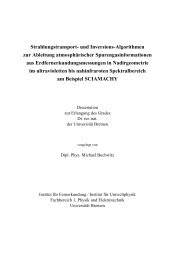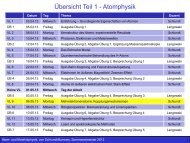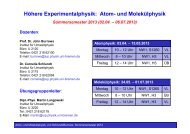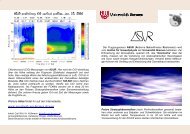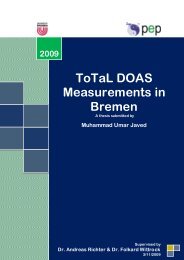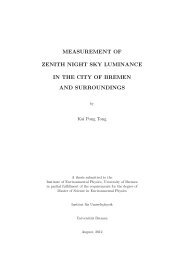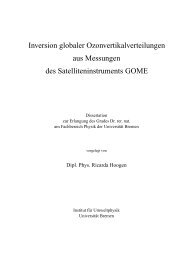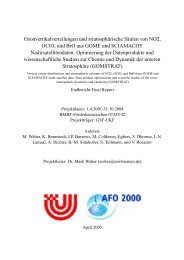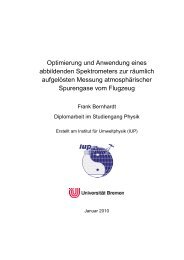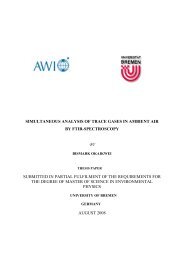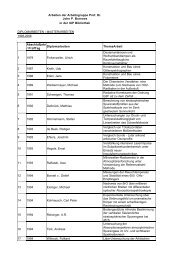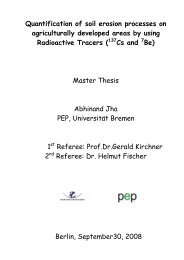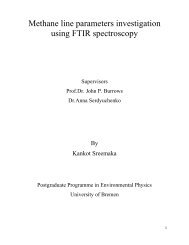True Coincidence Summing Correction in Gamma Spectroscopy
True Coincidence Summing Correction in Gamma Spectroscopy
True Coincidence Summing Correction in Gamma Spectroscopy
You also want an ePaper? Increase the reach of your titles
YUMPU automatically turns print PDFs into web optimized ePapers that Google loves.
The peaks due to summ<strong>in</strong>g with X-rays appear after major gamma ray due to<br />
electron capture decay. Additionally, γ-γ co<strong>in</strong>cidences between few Sm-152 high<br />
abundance gamma rays can be detected. For the branched Eu-152 decay, radiations<br />
orig<strong>in</strong>at<strong>in</strong>g <strong>in</strong> different cascades do not <strong>in</strong>dicate summ<strong>in</strong>g. e.g. there is no summ<strong>in</strong>g<br />
between the 121.78 keV and the 344.28 keV gamma-rays or between the Sm branch<br />
X-rays and the Gd branch gamma-rays. However, <strong>in</strong> the spectrum, the (344.28 +<br />
778.90) sum peaks do appear with the beta decay branch.<br />
The sum peaks correspond only to a small fraction of counts lost from ma<strong>in</strong> peak<br />
because summ<strong>in</strong>g can be due to a partially absorbed gamma ray. S<strong>in</strong>ce only a small<br />
number of gamma rays are fully absorbed, the summ<strong>in</strong>g between a full energy peak<br />
gamma ray with partially absorbed gamma ray is possible. This can be seen <strong>in</strong><br />
Figure-2.5, where the level of the background cont<strong>in</strong>uum at high-energy side of the<br />
peaks is greater than that at the low-energy side <strong>in</strong> the spectrum affected by TCS.<br />
Such co<strong>in</strong>cidences with partially absorbed gamma rays must be taken <strong>in</strong>to account if<br />
TCS correction is to be computed.<br />
Furthermore, <strong>in</strong> case of beta decay, a beta particle and the deexcitation gamma-rays<br />
are emitted almost at the same <strong>in</strong>stant, a gamma-ray may sum with the<br />
bremsstrahlung produced as the beta particle is slowed down.<br />
2.5 Experimental Evidence of the Need for <strong>Correction</strong>s<br />
The true co<strong>in</strong>cidence corrections can also be estimated experimentally with sources<br />
that emit both co<strong>in</strong>cident and non-co<strong>in</strong>cident photons. Spectra can be recorded for<br />
the sources placed both at a distance d 0 from the detector and at the closer distance<br />
d chosen for the actual measurements. Analyz<strong>in</strong>g comparatively, the ratio of the peak<br />
count rates n(d) and n(d 0 ) should be a smooth function of the energy for the nonco<strong>in</strong>cident<br />
photons. The amount by which the ratios for the co<strong>in</strong>cident photons<br />
deviate from this function gives an estimate for the co<strong>in</strong>cidence-summ<strong>in</strong>g corrections.<br />
An example for this method is given <strong>in</strong> Figure 2.6 where the typical co<strong>in</strong>cidencesumm<strong>in</strong>g<br />
correction factors are 60/50 = 1.2 [1]<br />
23



